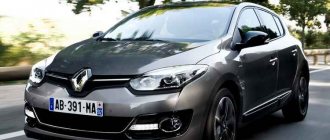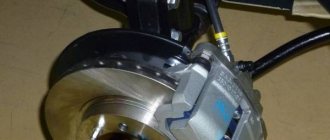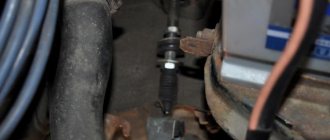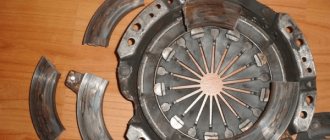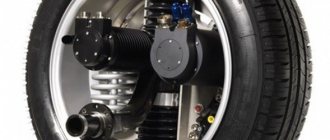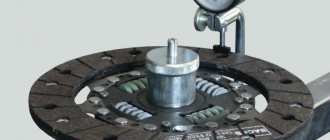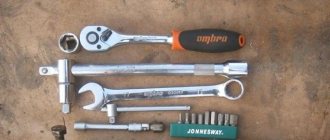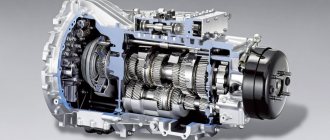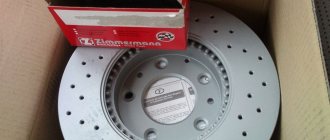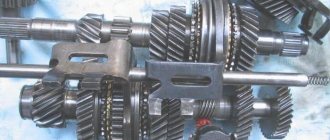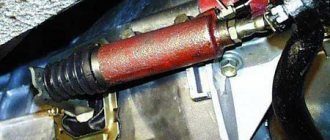Technological processes
According to the technical documentation and recommendations of most car manufacturers, it is necessary to depress the clutch of the power unit during the starting process, when the vehicle has been standing for more than 6 hours (for the winter period - 4 hours).
So, there are two different opinions about whether it is necessary to depress the clutch when starting the power unit. Some supporters say it is necessary, while others say it is not. Having considered all the arguments for and against, on both sides, as well as the technical manuals for operating vehicles, several conclusions arise:
- When starting with the clutch depressed, the starter consumes less electricity, since auxiliary components (gearbox, cardan, axle gearbox) are switched off.
- It is easier for the starter and crankshaft to turn in engine oil that has thickened.
- On a number of vehicles, the engine simply does not start (this applies especially to American vehicles).
Now let's look at the cons:
- When squeezing the clutch before starting, the bearing is still dry and therefore subject to increased wear.
- In winter, when starting the engine is especially difficult, it is necessary to fill in winter engine oils.
Drawing a general conclusion, we can say that car enthusiasts are divided into two groups - those who are for and against pressing the clutch when starting the power plant..
What's the result?
If you analyze the information received, it becomes clear that in the cold season it is better to depress the clutch on a cold internal combustion engine. This will, first of all, make it easier to start the engine and extend the life of the starter.
The fact is that in practice the following happens - by taking care of the life of the crankshaft bearing and not squeezing the clutch, the driver thereby reduces the life of the starter. To this should be added the accelerated failure of the battery. The release bearing and other elements of the clutch itself also suffer.
It turns out that during operation it will be more expensive to change batteries and constantly repair the starter than to not press the clutch on principle, citing the support bearing. If your car is from the group of cars that do not start without pressing the clutch, then you should not consider this feature as a problem at all.
Finally, we note that even taking into account the disagreements, both supporters and opponents of clutch release agree on one thing - the car must be prepared taking into account seasonality.
It is very important to choose the right engine oil and spark plugs for a specific engine type. In winter, you need to use the best option from low-viscosity oils to facilitate the rotation of the shafts in the internal combustion engine and gearbox.
As for novice drivers, you should make it a rule to put the car on the parking brake (the exception is in the winter, when the brake pads may freeze after being idle), and also always check that the gearbox is set to neutral before starting.
Another option that will solve the issue of clutch release is to purchase a car with an automatic transmission. At the same time, do not forget that such a car will initially be more expensive.
Also, cars with automatic transmission are more difficult to maintain, and certain restrictions are imposed during operation (the gearbox must be warmed up before driving, slipping in mud, snow or ice is prohibited, it is highly undesirable or completely prohibited to tow a car with an automatic transmission on a cable, etc.).
Engine speed and service life. Disadvantages of driving at low and high speeds. At what engine speed is it best to drive? Tips and tricks.
Why is it necessary to depress the clutch when starting the engine?
Now let's look at the technical side of the issue. Starting the engine is difficult, especially when the vehicle has been standing for a long time. To this factor it is worth adding frost in the winter season. In this case, the oil thickens and it is quite difficult for the starter to turn the crankshaft and the input shaft of the gearbox.
All this may lead to the fact that the starting electrical device will not be able to crank the crankshaft the first or second time, and the battery will simply run out.
To avoid unpleasant consequences, it is necessary to depress the clutch and disconnect the gearbox from the starting process. Then the power unit can start without load, be it a gearbox, driveshaft or rear axle. Therefore, it is imperative to depress the clutch pedal to facilitate starting the engine.
Summary
A car enthusiast can either press the clutch when starting the engine or do without it (if the choice of a specific action is not determined by objective criteria).
Squeezing the clutch can be a procedure that not only creates controversial points, but is also extremely significant in practice - especially in situations where an emergency restart of the engine is required. And it is not at all surprising that this procedure is popular among Russian car enthusiasts. On the one hand, the procedure in question is very simple, on the other hand, it is aimed at increasing the efficiency of using the vehicle.
Arguments against"
Opponents of clutch squeezing argue their position mainly by the fact that regular squeezing of the pedal can be accompanied by increased wear of the crankshaft bearing in the clutch mechanism. This is due to the fact that when the machine is idle for a long time, oil drains from the bearing, and its sudden use is characterized by increased wear.
Moreover, a worn clutch bearing, as car enthusiasts note, may begin to operate with play, which is accompanied by the transfer of vibration to neighboring mechanisms (which can, in turn, lead to their damage).
If the car enthusiast follows the first point of view - according to which it makes sense to squeeze the clutch, then the result of such a preference may be the conservation of electrical equipment resources (in the presence of an increased risk of damage to the crankshaft bearing). In turn, the second position involves an emphasis on maintaining the functionality of the key mechanical part of the clutch - while the functioning of the electrical equipment is relegated to the background.
When choosing a point of view on the issue under consideration that is acceptable for a particular motorist, it is legitimate to focus on both the technical and economic aspects of using a car. That is, to estimate, relatively speaking, what will be more expensive - repairing the crankshaft or replacing the battery (based on the estimated frequency of such replacement) on a specific car.
Service Braking Options
Now I’ll move on to specifics and describe possible braking options. The first two options are for beginners who have yet to master more advanced braking techniques.
Coasting braking
Braking in neutral gear or with the clutch pedal depressed. Method of braking teapots. In its pure form, it is applicable only before stopping the car, when driving at low parking speeds downhill or during emergency braking with ABS (read about this below). In other cases, it is considered driver error, since this method of braking does not take advantage of many safety opportunities. You can remember why this is an error with the help of the articles “Engine Torque”, “Coasting” and “How to Brake Correctly on Mechanics? Part 1".
Combined braking in constant gear
This method is better than the previous one, but it also has its drawback - loss of engine traction when the speed drops below 2500 (on naturally aspirated gasoline engines) with all possible consequences. In its pure form, it is better to use it during short-term braking, when the engine speed decreases slightly and gear shifting is not required.
And I will list advanced methods of braking, which in fact are not advanced, but basic and correct. All of these methods involve shifting gears down, which is possible both using throttle shifting and “head-on”, without shifting the throttle. Braking options with downshifts without re-gearing, although better than the previous two, are not ideal, since they occur with jerking of the car. Jerks negatively affect the safety of braking, the service life of the gearbox and clutch, and the comfort of passengers, so I will not consider techniques without shifting the throttle here and will go straight to the ideal braking options - with shifting gears down and shifting the throttle. For more information on how to engage downshifts, read the article “How to downshift?”
Engine braking with downshifts and throttle shifts
Ideal for braking on slippery roads, for adjusting speed in traffic, for safe and economical braking before traffic lights. Indispensable in case of failure of the service brake system. Often used by drivers familiar with defensive driving principles. The smoothest, safest, most economical and comfortable way to braking. Read about this also in the articles “How to brake correctly: with the engine or the brakes?” and “The Dangers of Winter Driving.”
Engine braking is simple:
- release the gas pedal;
- slow down;
- when the tachometer needle drops to 2500 rpm, we lower the gears with a shift;
- After engaging second gear, we slow down in it and press the brake pedal to come to a complete stop.
- If we are braking on ice or if after braking we need to continue driving at a speed of less than 10 km/h, you can shift up to 1st gear. Let me remind you that we depress the clutch pedal only after the tachometer needle reaches 1000 rpm.
You can engage a lower gear at high speeds. The higher they are, the more intense the braking and the harder you need to press the gas pedal when changing the throttle. If the service brake system fails, use the maximum possible engine braking: at maximum speed and in the lowest gears. That is, so that after shifting the gear down, the tachometer needle rises to the red zone. We work on all this in the course “The Magic of Gear Shifting”.
Combined braking with downshifting and throttling
The technique is performed in the same way as engine braking, only pressing the brake pedal is added to it. The most commonly used braking option in the city. Used if engine braking is not enough and you need to add a little more pressure on the brake pedal. Otherwise everything is the same: downshifts and shifts.
The sequence of actions is as follows:
- press the brake pedal;
- when the tachometer needle drops to 2500 rpm, take your foot off the brake pedal and shift the throttle;
- engage a lower gear and return your foot to the brake;
- We continue the described cycle of actions until the second gear is engaged and brake in it until it stops.
And now the most lethal method of braking is racing!
Combined braking with downshift and heel shift
The most effective way to brake. What kind of heel overthrow is this?! And you ask our racing driver friends who came up with such a perversion. Analyze the previous method of braking: to make a gas change, you need to move your right foot from the brake to the gas. This means that during throttling we lose in braking. You can afford this if there is a lot of space on the road and smooth braking is quite safe. But when there is little space and intense braking is needed, you cannot take your foot off the brake. In this case, you can use the same foot to both brake and shift the throttle.
What kind of heel overthrow is this?! And you ask our racing driver friends who came up with such a perversion. Analyze the previous method of braking: to make a gas change, you need to move your right foot from the brake to the gas. This means that during throttling we lose in braking. You can afford this if there is a lot of space on the road and smooth braking is quite safe. But when there is little space and intense braking is needed, you cannot take your foot off the brake. In this case, you can use the same foot to both brake and shift the throttle.
The classic racing option: we brake with the toe of the foot and shift the throttle with the heel. This is not convenient on all cars, and during quiet city driving it is more convenient to change the throttle with the right side of the foot. And brake, accordingly, with the left side. This option is applicable only on cars with close proximity of the brake and gas pedals.
I understand that heel throttling is not a technique for the faint of heart and I do not insist on it. If you own and use it, honor and praise be to you. If not, you can do without it. But what then should you do if you need intense braking and there is no way to take your foot off the brake to shift the throttle? Then use option 2 - combined braking in a constant gear. We slowed down to the required speed, say, from 80 km/h in 5th gear to 30 km/h, after which we immediately engaged 2nd gear and drove on. Of course, in this case, it is advisable to shift the throttle and release the clutch twice.
and I do not insist on it. If you own and use it, honor and praise be to you. If not, you can do without it. But what then should you do if you need intense braking and there is no way to take your foot off the brake to shift the throttle? Then use option 2 - combined braking in a constant gear. We slowed down to the required speed, say, from 80 km/h in 5th gear to 30 km/h, after which we immediately engaged 2nd gear and drove on. Of course, in this case, it is advisable to shift the throttle and release the clutch twice.

